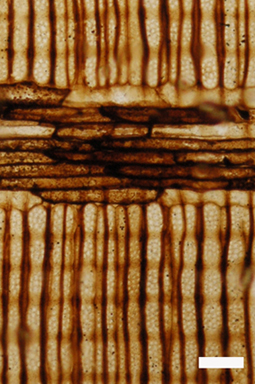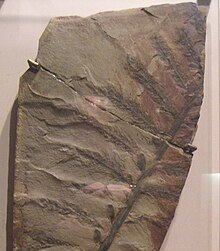Archaeopteris
| Archaeopteris | ||||||||||||
|---|---|---|---|---|---|---|---|---|---|---|---|---|

Radial section through the wood of Archaeopteris (bar = 1 mm) |
||||||||||||
| Temporal occurrence | ||||||||||||
| Upper Devonian to Lower Mississippium | ||||||||||||
| 385 to 345 million years | ||||||||||||
| Systematics | ||||||||||||
|
||||||||||||
| Scientific name | ||||||||||||
| Archaeopteris | ||||||||||||
Archaeopteris is a fossil genus of vascular plants and was for a time the oldest known tree in the true sense of the word. The wood was previously listed as a separate genus Callixylon , but is now assigned to the genus Archaeopteris . The name Archaeopteris means“ancient fern”in Greek .
features
The wood is very similar to that of today's naked men . The formation of the wood was also similar. The trunks had a diameter of up to one meter and a height of up to 30 meters. The growth did not only take place at the tip of the shoots, as was customary until then. Archaeopteris also formed side buds , and from them side shoots that could replace the main shoot. Another new feature was the bifacial cambium , which gave off wood on the inside and bast on the outside. Secondary growth in thickness occurs here for the first time . With this growth form, the tree reached an age of 40 to 50 years.
The root system was also more pronounced than in the plants that had existed until then. If these reached a depth of a maximum of 20 centimeters, the root system of Archaeopteris reached up to a meter deep.
The telomes of the leaves are fan-shaped, so the fronds were already flat. Within the feathers the telome were forked, but the telome ends were not completely fused, but partly free or slashed at the edge.
Archaeopteris was deciduous: branch systems were shed at unfavorable times of the year: branches with side branches on which the leaves were attached. These branches are the most common fossils.
Propagation took place via spores. Archaeopteris was heterospore , so it formed small male microspores and large female megaspores.
distribution
Archaeopteris was distributed worldwide. There are sites in North America, Europe, Siberia, China, as well as the Gondwana continents Africa, Australia, South America and Antarctica. The paleo-latitudes range from equatorial to subpolar.
Until their extinction at the transition from the Devonian to the Carboniferous around 355 million years ago, Archaeopteris plants formed the main stock of the earliest forests .
The temporal distribution of Archaeopteris ranges from the Upper Devonian to the Lower Mississippian .
Systematics
Archaeopteris is the largest genus within the order of the Archaeopteridales. Today this is usually placed with the progymnosperms , a group that mediates between the ferns and the seed plants. This intermediate position also corresponds to the characteristics: the conifer-like wood and the fern-like leaves and spores.
The genus first appeared in the Middle Devonian, was widespread in the Upper Devonian, but died out at the end of the Devonian. It is a key fossil for the Upper Devonian.
Other genera are much rarer. The small genus Eddya is also interpreted as the seedling of Archaeopteris .
Sources and further information
The article is based on the following sources:
Individual evidence
- ↑ Archaeopteris was replaced by Eospermatopteris in 2007 , cf. WE Stein et al .: Giant cladoxylopsid trees resolve the enigma of the Earth's earliest forest stumps at Gilboa . Nature Volume 446, p. 904, 2007. doi : 10.1038 / nature05705
- ^ Charles B. Beck, David C. Wight: Progymnosperms . In: Charles B. Beck (Ed.): Origin and Evolution of Gymnosperms . Columbia University Press, New York 1988, ISBN 0-231-06358-X , here p. 32.
